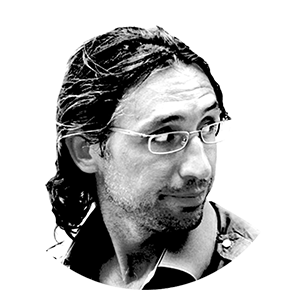Aveva 106 anni l’artista che ha legato il suo nome soprattutto a Bambi, nella “Fabbrica del Topo”. Ciò in tempi assai turbolenti, venati di sentimenti discriminatori paragonabili a quelli espressi da una buona parte degli elettori di Donald Trump (che Giove ce la mandi buona, proteggendoci dalle nevrotiche paure di questi incappucciati per l’imminente 2017!).
Non ho mai avuto modo di incontrare il grande Tyrus Wong, l’ha fatto Federico Fiecconi, in alcuni dei suoi viaggi negli States, riportando foto, memorie, arte del Maestro.
Qui sono insieme in una foto dello scorso maggio, riportata da Fumo di China.
Da vari siti che parlano di lui ricavo alcune note biografiche al volo.
Wong was born in Taishan, Guangdong, China. In 1920, when he was 9 years old, Wong and his father emigrated to the United States, and never again came into contact with his mother and sister. Wong was held on Angel Island initially, due to the Chinese Exclusion Act.
He was separated on the island from his father, the only child in sight. “Nine years old, I was scared half to death,” he later recalled. After his release from Angel Island, he and his father initially relocated to Sacramento. His father moved the family to Los Angeles.
Wong’s career included working as a greeting card designer to Warner Bros. film production illustrator (1942–1968), from drawing set designs and storyboard for several movies to being a Disney inspirational sketch artist (1938–1941). It w[s his lush pastels that served as inspiration for Bambi (1942) where he was the lead artist of the project.
Wong left Disney studios shortly after finishing Bambi, due to repercussions from the Disney animators’ strike. Later, he designed popular greeting cards for Hallmark, some of his Christmas cards selling over 1 million copies.
Some of his well known paintings include Self Portrait (late 1920s), Fire (1939), Reclining Nude (1940s), East (1984) and West (1984). He told an interviewer that he’s a “lucky artist.”
Wong was featured in Mark Wexler‘s documentary How to Live Forever, where he discussed his daily lifestyle and his view on mortality.
He was married to Ruth Ng Kim (伍梅珍), a second-generation Chinese American from a farming family in Bakersfield, California. Ruth worked as a lawyer but became a homemaker after the birth of their children. The couple has three daughters: Kay (born 1938), Tai-ling (born 1941), and Kim (born 1946) and two grandchildren. Wong refers to his daughters as his “greatest achievements.”
After retiring in 1968, Wong continued to create colorful kites (usually animals such as pandas, goldfish, or centipede). He spent his Saturdays flying his creations on the Santa Monica Pier.
In 2001, Wong was named a Disney Legend, and in October 2016 Wong received two honors at the Asian World Film Festival. He was awarded with a lifetime achievement award on the opening day with the following day (his 106th birthday) being the screening of the documentary about him titled “Tyrus” directed by Pam Tom.
In August 15, 2013 thru February 3, 2014, Wong’s work was exhibited at The Walt Disney Family Museum in San Francisco, California in a career retrospective entitled: Water to Paper, Paint to Sky: The Art Of Tyrus Wong. In conjunction with the exhibit, a hardcover book that documents the same was published by the Walt Disney Family Foundation Press.
Wong is survived by his daughters Kim, Kay and Tai-Ling.







